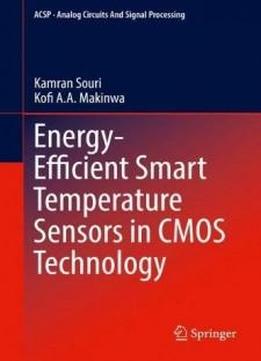
Energy-efficient Smart Temperature Sensors In Cmos Technology (analog Circuits And Signal Processing)
by Kofi A.A. Makinwa /
2017 / English / PDF
2.5 MB Download
This book describes the design and implementation of
energy-efficient smart (digital output) temperature sensors in
CMOS technology. To accomplish this, a new readout topology,
namely the zoom-ADC, is presented. It combines a coarse SAR-ADC
with a fine Sigma-Delta (SD) ADC. The digital result obtained
from the coarse ADC is used to set the reference levels of the
SD-ADC, thereby zooming its full-scale range into a small region
around the input signal. This technique considerably reduces the
SD-ADC’s full-scale range, and notably relaxes the number of
clock cycles needed for a given resolution, as well as the
DC-gain and swing of the loop-filter. Both conversion time and
power-efficiency can be improved, which results in a substantial
improvement in energy-efficiency. Two BJT-based sensor prototypes
based on 1st-order and 2nd-order zoom-ADCs are presented. They
both achieve inaccuracies of less than ±0.2°C over the military
temperature range (-55°C to 125°C). A prototype capable of
sensing temperatures up to 200°C is also presented. As an
alternative to BJTs, sensors based on dynamic threshold MOSTs
(DTMOSTs) are also presented. It is shown that DTMOSTs are
capable of achieving low inaccuracy (±0.4°C over the military
temperature range) as well as sub-1V operation, making them well
suited for use in modern CMOS processes.
This book describes the design and implementation of
energy-efficient smart (digital output) temperature sensors in
CMOS technology. To accomplish this, a new readout topology,
namely the zoom-ADC, is presented. It combines a coarse SAR-ADC
with a fine Sigma-Delta (SD) ADC. The digital result obtained
from the coarse ADC is used to set the reference levels of the
SD-ADC, thereby zooming its full-scale range into a small region
around the input signal. This technique considerably reduces the
SD-ADC’s full-scale range, and notably relaxes the number of
clock cycles needed for a given resolution, as well as the
DC-gain and swing of the loop-filter. Both conversion time and
power-efficiency can be improved, which results in a substantial
improvement in energy-efficiency. Two BJT-based sensor prototypes
based on 1st-order and 2nd-order zoom-ADCs are presented. They
both achieve inaccuracies of less than ±0.2°C over the military
temperature range (-55°C to 125°C). A prototype capable of
sensing temperatures up to 200°C is also presented. As an
alternative to BJTs, sensors based on dynamic threshold MOSTs
(DTMOSTs) are also presented. It is shown that DTMOSTs are
capable of achieving low inaccuracy (±0.4°C over the military
temperature range) as well as sub-1V operation, making them well
suited for use in modern CMOS processes.











